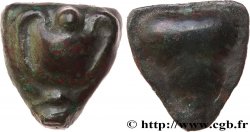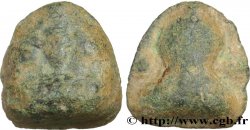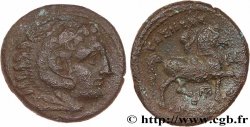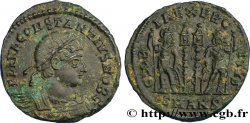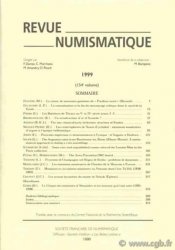v57_0028 - SICILY - SELINUS Tétradrachme
MONNAIES 57 (2013)
Starting price : 850.00 €
Estimate : 1 400.00 €
unsold lot
Starting price : 850.00 €
Estimate : 1 400.00 €
unsold lot
Type : Tétradrachme
Date: c. 450 AC.
Mint name / Town : Sélinonte Sicile
Metal : silver
Diameter : 29 mm
Orientation dies : 9 h.
Weight : 16,55 g.
Rarity : R2
Coments on the condition:
Exemplaire sur un flan très large, parfaitement centré des deux côtés. Usure importante, mais parfaitement lisible et identifiable. Beau droit. Revers de style fin avec tous les détails visibles. Une épaisse patine grise avec des reflets dorés, légèrement granuleuse recouvre l’exemplaire
Catalogue references :
Predigree :
Cet exemplaire provient de MONNAIES 41, n° 60
Obverse
Obverse legend : ANÉPIGRAPHE.
Obverse description : Bige passant à droite, conduit par Artémis, accompagnée d'Apollon bandant un arc ; à l’exergue un grain d’orge couché à droite.
Reverse
Reverse description : Le dieu-fleuve Sélinos, nu debout à gauche, tenant une phiale de la main droite et une branche de laurier de la main gauche, sacrifiant au-dessus d'un autel orné d'un coq tourné à gauche ; derrière Sélinos sur une base, timbrée, un taureau tourné à gauche surmonté d'une feuille de sélinon.
Reverse legend : SEL-INONT-I-ON
Reverse translation : (de Sélinonte).
Commentary
Importante cassure de coin visible au revers, visible au niveau du genou de Selinos. Même coin de revers que l’exemplaire de la collection Pozzi, Naville I, n° 543.
Significant corner break visible on the reverse, visible at the level of Selinos' knee. Same reverse die as the copy in the Pozzi collection, Naville I, no. 543
Significant corner break visible on the reverse, visible at the level of Selinos' knee. Same reverse die as the copy in the Pozzi collection, Naville I, no. 543








 Report a mistake
Report a mistake Print the page
Print the page Share my selection
Share my selection Ask a question
Ask a question Consign / sell
Consign / sell
 Full data
Full data

